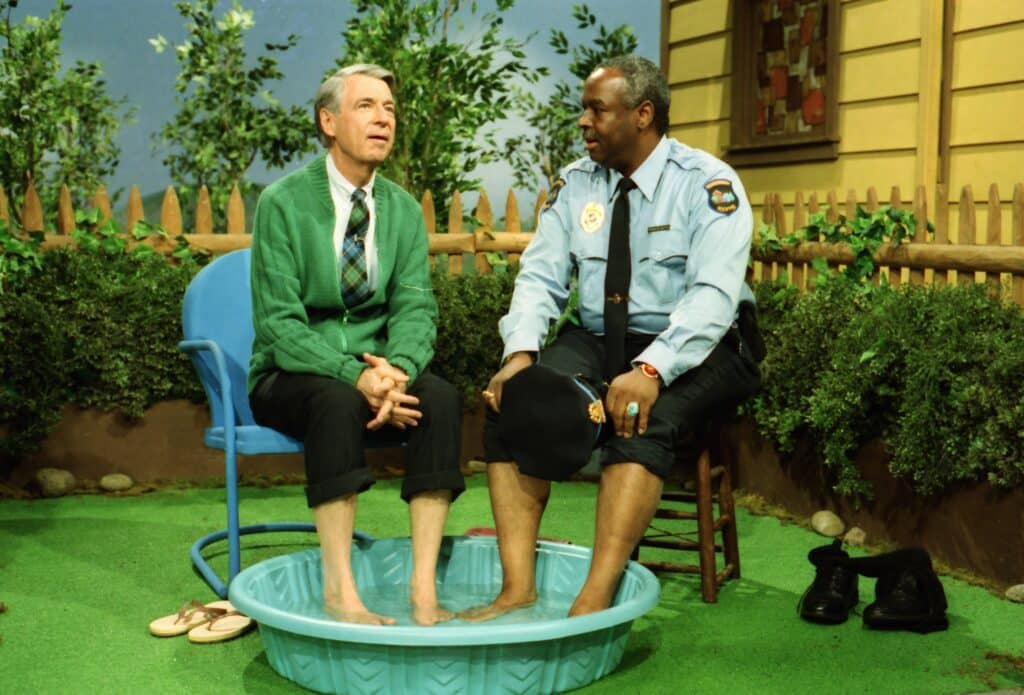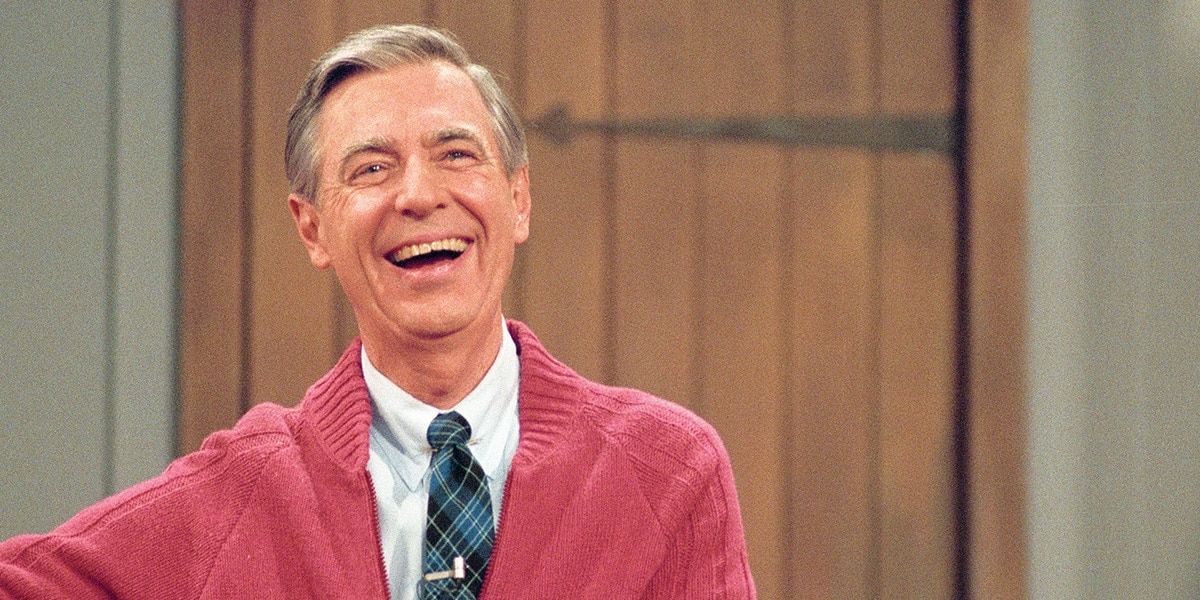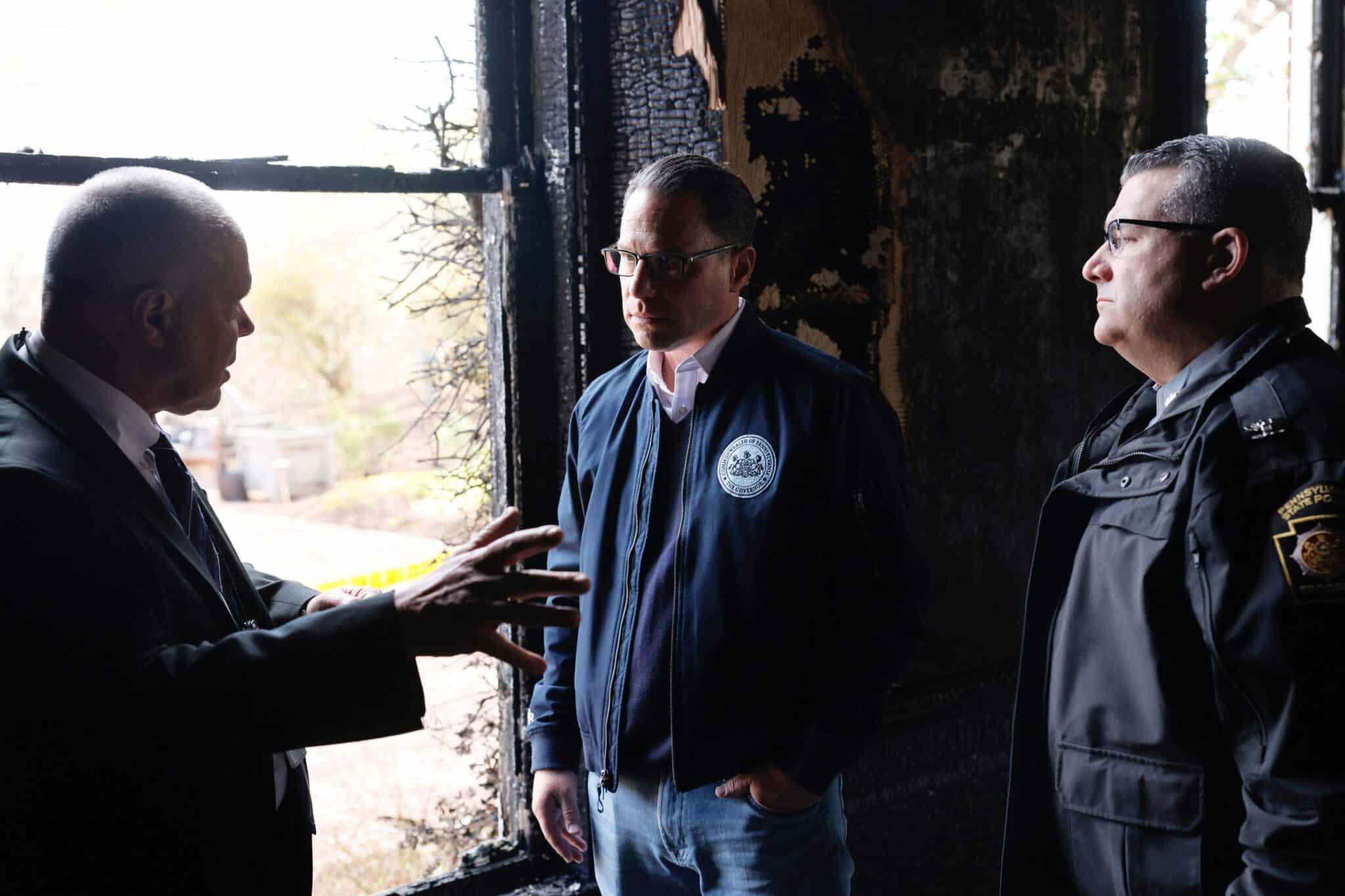Fred Rogers changed the world with his message of love and respect for our neighbor. The Fred Rogers Center in Latrobe, Pennsylvania, continues to spread that message.
Perhaps no one other than Jesus Christ is more noted for speaking about love of neighbor than Fred Rogers. Better known as Mister Rogers and as the creator of the children’s television program Mister Rogers’ Neighborhood, Fred Rogers welcomed people into his neighborhood for over 30 years. He died on February 27, 2003, but his legacy of neighborliness and caring for children lives on through the Fred Rogers Center for Early Learning and Children’s Media.
Located in his hometown of Latrobe, Pennsylvania, the center lies 40 miles east of Pittsburgh, on the campus of Saint Vincent College, a Catholic Benedictine liberal arts institution. Although Rogers was an ordained Presbyterian minister, he shared a lifelong friendship with Douglas Nowicki, an archabbot of Saint Vincent, and felt that Latrobe was his “first neighborhood.” Before his death, Rogers made plans to establish his legacy at the college.
“Fred had talked to the archabbot back in the 1990s about establishing a center here. He was going to teach and live at the center, but he died in 2003,” says Dana Winters, PhD, director of simple interactions and academic programs at the center. “We knew he wanted to continue to help children.”
Developing Healthy Children
Ground was broken in 2006 for the two-level facility that overlooks the rolling farmlands and Chestnut Ridge of the Allegheny Mountains. The center opened in 2008 with the mission to help children grow on the inside, learn through relationships, and give meaning to technology through three initiatives at the center: academic, digital media and learning, and archiveology.
Rogers believed that human relationships are crucial to a child’s development. “Academically, through Saint Vincent College, we offer a minor in children’s studies that is inspired by the works of Fred Rogers and which is available to students in all schools in the college,” says Dr. Winters.
The center also houses a research lab called Incubator 143. “It was named for Fred’s favorite number and symbolizes the phrase I love you. The number 1 represents the word I, and 4 stands in for love, and 3 symbolizes you,” Dr. Winters says. The incubator is an undergraduate research and development group focused on creating positive change for children’s development by supporting the work of childcare centers, urban schools, nonprofit community programs, and overseas orphanages.
In addition, the center is home to the Fred Rogers Scholars Program. “Each year, five freshmen students are selected as Fred Rogers Scholars and receive a $2,500 merit-based scholarship per year. The scholarship is awarded to students pursuing careers or interested in doing graduate work that helps young children grow and become confident, competent, and caring human beings in keeping with the mission of the Fred Rogers Center,” says Dr. Winters.
Students in their first year learn about Rogers himself—his work, his philosophy, and the archives. In year two of the program, students commit to a service-learning project. In year three, students define a culminating project that will be finished and presented in their fourth year.
“Honestly, besides my faith, my family, and my friends, Fred Rogers has had the greatest impact on the person I am today,” says Sydney Schoff, 21, a senior Fred Rogers Scholar majoring in communications. “It is extremely difficult for me to even put into words how important Fred was and is to me. He had this incredible ability to meet people where they are. He never saw people as ‘someone that will be great one day.’ Fred’s ‘one day’ was every day.”
“Fred Rogers’ work and legacy have impacted the way I view the world and those around me. He approached every interaction with unparalleled intimacy that I now attempt to implement in my daily life,” says Kyle Ward, 21, a senior psychological science major and Fred Rogers Scholar.
A Friend to God’s People
The second initiative of the center is digital media and learning. In 2012, the Fred Rogers Center joined with the National Association for the Education of Young Children to release a position statement, “Technology and Interactive Media as Tools in Early Childhood Programs Serving Children from Birth through Age 8,” which provided research-based guidance to early childhood programs and educators on the effective use of media and technology.
“We believe children grow best through relationships with others, but we also know that technology can also promote that growth,” says Dr. Winters. “The digital media and learning program poses this question: It’s fine to use technology, but are you using it for good?”
The last initiative is the Fred Rogers Archive, which is housed at the center and contains more than 16,000 items. Among them are handwritten texts, scripts, and production books from Mister Rogers’ Neighborhood, his iconic sweaters and tennis shoes, the Neighborhood’s Make-Believe Trolley, and beloved puppets such as King Friday and X the Owl.
The center also contains the Fred Rogers Exhibit, which is open to the public and enjoyable for both adults and children. The multimedia, interactive display traces Rogers’ life and career. It documents his childhood in Latrobe, his rise as an advocate for children, and his dream of building a legacy through the Fred Rogers Center. The exhibit features video clips, his sweaters, puppets, and some of the numerous honors and awards he received, which include a Lifetime Achievement Emmy Award and the Presidential Medal of Freedom.

But perhaps the most enduring legacy of Fred Rogers and that which inspires everything at the center is his subtle spirituality. Like St. Francis of Assisi, Rogers radiated a simple spirituality that drew people in.
Henri J.M. Nouwen, the Dutch Catholic priest and theologian who was a good friend of Rogers, said this of everyone’s favorite neighbor in his book Bread for the Journey: A Daybook of Wisdom and Faith: “Although we tend to think about saints as holy and pious, and picture them with halos above their heads and ecstatic gazes, true saints are much more accessible. They are men and women like us, who live ordinary lives and struggle with ordinary problems. What makes them saints is their clear and unwavering focus on God and God’s people.”
Birth of a Legacy
Rogers’ gift for being able to focus on God and God’s people began in childhood. He was born on March 20, 1928, to James and Nancy McFeely Rogers. His father, a prominent industrialist, owned the Latrobe Die Casting Company. Rogers was an only child for 11 years until his sister, Nancy Elaine, was born. His was a Father Knows Best kind of life. His mother volunteered at the local hospital and knit her son a sweater for Christmas each year. Until she died, those were the sweaters he wore on the show. His family members were faithful Presbyterians. During a 1999 interview with the Archive of American Television, when asked if he had a religious life, Rogers replied, “You bet we did, and what continues within me is the knowledge that each one of us can be used in perfectly wonderful ways.”
However, it took a while before Rogers would discover the way God intended for him to be used. He was an overweight, shy, lonely child who suffered with asthma and endured bullying. It was his maternal grandfather, Fred McFeely, who set the young Fred on the road to his destiny.
Rogers said this of a memory he had of his Grandfather McFeely: “I think it was when I was leaving one time to go home after our time together that my grandfather said to me, ‘You know, you made this day a really special day. Just by being yourself. There’s only one person in the world like you. And I happen to like you just the way you are.’ Well, talk about good stuff. That just went right into my heart. And it never budged. And I’ve been able to pass that on. And that’s a wonderful legacy.”
As he grew older, Rogers became more self-confident. After spending a year at Dartmouth College, he transferred to Rollins College in Florida, where he could hone his musical talents. In addition to a gift for music, he also felt called to ministry, and was accepted by the Pittsburgh Theological Seminary. While at Rollins College, he met his wife, Joanne, and earned a degree in music composition.
In 1951, during his senior year, he saw a television program for children that featured people throwing pies at each other. He found it demeaning for the children and decided he wanted to be involved with television.
Rogers married Joanne in 1952, and after working in New York City as an assistant producer for several NBC shows, he learned of a new educational broadcasting station launching in Pittsburgh. He returned home to help found WQED, the first community-owned public station in the country. There, he and Josie Carey volunteered to develop a program for children, and The Children’s Corner was born. The show became a hit and won a Sylvania Award for best locally produced children’s show in the country in 1955.
During this time, Rogers was also attending the Pittsburgh Theological Seminary. While taking a course in counseling, he decided that he wanted to serve children and worked with Dr. Margaret McFarland, the director of the Arsenal Family and Children’s Center, founded by the renowned pediatrician Dr. Benjamin Spock. Rogers spent hours observing children at play and interacting with them, using puppets he brought to the center.
Rogers graduated from the seminary in 1963 with a charge to minister to children and their families through television programming. The only problem was there was no money to support a television program.
Later that year, the Canadian Broadcasting Corporation invited Rogers to Toronto to create a children’s program. The 15-minute program required that he host the show and talk directly to children, something he hadn’t done before. By 1965, Rogers and his wife had two young sons and had decided to move back to Pittsburgh to be close to family and friends. He was also planning a new show called Mister Rogers’ Neighborhood.
The Quiet Radical
After several years of Mister Rogers’ Neighborhood running in limited broadcasting areas, the Sears-Roebuck Foundation offered to underwrite the show. On February 19, 1968, the first national broadcast of Mister Rogers’ Neighborhood aired.
One of the most tumultuous times in American history, 1968 gave us the assassinations of both Dr. Martin Luther King Jr. and Senator Robert Kennedy, riots at the Democratic National Convention, and violent anti-war protests. It also gave us Mister Rogers, a kind, gentle man in a sweater and tennis shoes. With all the shouting, it’s a wonder the nation heard this soft-spoken man over the racket. But hear him it did. Children across the country tuned in to hear Mister Rogers’ words of unconditional love and acceptance.
“Mr. Rogers was quite radical for his time, but in a quiet way,” Dr. Winters says. “On his show, he talked about what assassination meant. He discussed divorce and adoption, which was not done on television at that time.”
Rogers’ credo was, “If it is mentionable, it’s manageable,” and he encouraged children and their families to communicate their fears and feelings.
Although he was satirized on Saturday Night Live, Rogers was genuine. “The most surprising thing that I have discovered in studying Fred Rogers and his work is that the person who is portrayed on the screen was the real Fred Rogers. The talented, considerate, and genuinely kind individual who Fred Rogers was on television was the person he was in real life,” says Sarah O’Callaghan, 20, a junior early childhood education major and Fred Rogers Scholar.
“One of the most memorable things he did happened during the civil rights movement. In 1969, during a show, Mister Rogers invited the character Officer Clemmons, who was black, to rest his feet in a pool of water with him. Afterward, Mister Rogers wiped the feet of his neighbor,” says Dr. Winters.
The religious symbolism of this action may have gone unnoticed by the children viewing the show, but the love behind his deed did not. It was his subtle preaching of love of neighbor through his words and actions that endeared him to generations of children. Like St. Francis, who also carried a message of love and dignity to the world, Rogers’ gentleness and love affected people deeply.
He had an unusual ability to reach in and connect with the inner child in those he met. His philosophy was, “Deep and simple is far more essential than shallow and complex.” Through his simple songs such as “I Like You as You Are,” “You Are Special,” and “It’s You I Like,” he reached deeply into our hearts and touched them, and he also taught us how to love one another.
“Not only is Fred Rogers teaching me how to help others, but he’s teaching me how to be a good human. And I know that will help me as I settle into a career in the future,” says Lilly McCormick, 19, a sophomore communications major and Fred Rogers Scholar.
“Fred Rogers respected children. He never talked down to them, and he respected their feelings. He assured them of their self-worth and told them it was OK to have emotions,” says Dr. Winters. “And Fred Rogers regarded the space between the television and a child as holy ground.”
Mister Rogers On…
HELPERS
“When I was a boy and I would see scary things in the news, my mother would say to me, ‘Look for the helpers. You will always find people who are helping.'”
HEROES
“Anyone who does anything to help a child in his life is a hero to me.”
TIME
“You rarely have time for everything you want in this life, so you need to make choices. And hopefully your choices can come from a deep sense of who you are.”
IMPRESSIONS
“If you could only sense how important you are to the lives of those you meet; how important you can be to the people you may never even dream of. There is something of yourself that you leave at every meeting with another person.”
HONESTY
“The greatest gift you ever give is your honest self.”
SUCCESS
“There are three ways to ultimate success: The first way is to be kind. The second way is to be kind. The third way is to be kind.”
FORGIVENESS
“Forgiveness is a strange thing. It can sometimes be easier to forgive our enemies than our friends. It can be hardest of all to forgive people we love. Like all of life’s important coping skills, the ability to forgive and the capacity to let go of resentments most likely take root very early in our lives.”
HEAVEN
“The kingdom of God is for the brokenhearted.”









1 thought on “Mister Rogers’ Legacy”
Thank you for sharing the life and legacy of Mister Rogers. It is good to know that his work will go on in the lives of the individuals who study his work at St. Vincent College, as well as those of us in early childhood that will continue to make his work known.
Blessings to the Administration of the College and the directors of the Mister Rogers Center.